Overview
This article serves as a compassionate guide for using a fructosamine calculator in diabetes management. It highlights the importance of assessing short-term glycemic control, which can often feel overwhelming. By walking you through the step-by-step process, it explains how fructosamine levels play a crucial role in monitoring blood glucose.
Understanding these levels can empower you to make informed treatment decisions, enhancing your overall health outcomes. You're not alone in this journey, and this tool can be a valuable resource to support you in managing your diabetes effectively. Remember, seeking clarity and support is a vital step toward better health.
Introduction
In the realm of diabetes management, understanding the nuances of blood glucose monitoring is vital for achieving optimal health outcomes. It's understandable to feel overwhelmed as you navigate this journey. Among the various tools available, fructosamine testing stands out as a crucial marker, providing insights into short-term glycemic control. Unlike the more commonly known HbA1c test, which reflects glucose levels over a three-month period, fructosamine offers a snapshot of average blood glucose levels over the previous two to three weeks. This makes it particularly valuable for individuals who have recently changed their treatment plans or lifestyle.
As diabetes care evolves, the integration of fructosamine testing into routine assessments can empower you to make informed decisions and tailor your management strategies effectively. You're not alone in this journey; we are here to support you every step of the way. Ultimately, this approach can enhance your quality of life, helping you feel more in control of your health.
Understanding Fructosamine: A Key Marker in Diabetes Management
Fructosamine is a compound that forms when glucose binds to proteins in the blood, primarily albumin. It serves as a vital indicator for average blood glucose values over the preceding 2 to 3 weeks, making it particularly useful for evaluating short-term glycemic control. This trait sets it apart from HbA1c, which indicates glucose concentrations over a longer period of around three months.
For those managing blood sugar, especially individuals who have recently altered their treatment or lifestyle, fructosamine provides a more immediate understanding of their glycemic condition. This enables quicker adjustments based on recent glucose readings, helping you feel more in control of your health.
Typically, the average levels of glycated proteins in individuals with Type 2 Diabetes range from 200 to 285 umol/L. Levels exceeding 250 umol/L are significantly associated with the onset of retinopathy, even in patients with HbA1c levels below 7.0% (53 mmol/mol). This statistic highlights the importance of monitoring specific blood markers as part of your overall health strategy.
Experts emphasize the essential role of fructosamine in diabetes management. Endocrinologists point out that it serves as a valuable tool for assessing glycemic control, particularly in situations where HbA1c may not provide a complete picture. For example, in cases of hemoglobinopathies or conditions affecting red blood cell turnover, fructosamine can offer a more reliable evaluation of glucose levels.
As noted by JRNN, "All authors approved the final version of the manuscript," indicating a consensus on the importance of these findings.
Recent studies have shown J-shaped connections between amino sugar concentrations and various health outcomes, including mortality. This underscores the need for careful monitoring. Elevated amino sugar concentrations are linked to increased risks, emphasizing the importance of maintaining ideal values. Real-world examples show how healthcare providers use sugar measurement assessments to tailor treatment plans effectively.
For instance, a patient experiencing fluctuating blood glucose readings may benefit from a fructosamine test to guide timely dietary or medication adjustments.
Additionally, T2DSolutions highlights the emerging concept of Type 3 Diabetes, which is associated with Alzheimer’s disease and insulin resistance in the brain. By raising awareness and providing reliable information about Type 3 Diabetes, T2DSolutions contributes to better preventive strategies and care for individuals at risk of this condition.
In its commitment to blood sugar education, T2DSolutions offers tools and calculators for converting specific sugar levels to A1C. This enables individuals to gain a clearer understanding of their glycemic control. Understanding the fructosamine calculator is essential for anyone managing blood sugar conditions. It not only informs treatment decisions but also enhances overall health outcomes by offering a clearer picture of short-term glycemic control.
As the landscape of blood sugar control evolves, integrating sugar levels into regular evaluations can empower you to take charge of your wellness more effectively. Explore T2D Solutions for more information on blood sugar management and education.
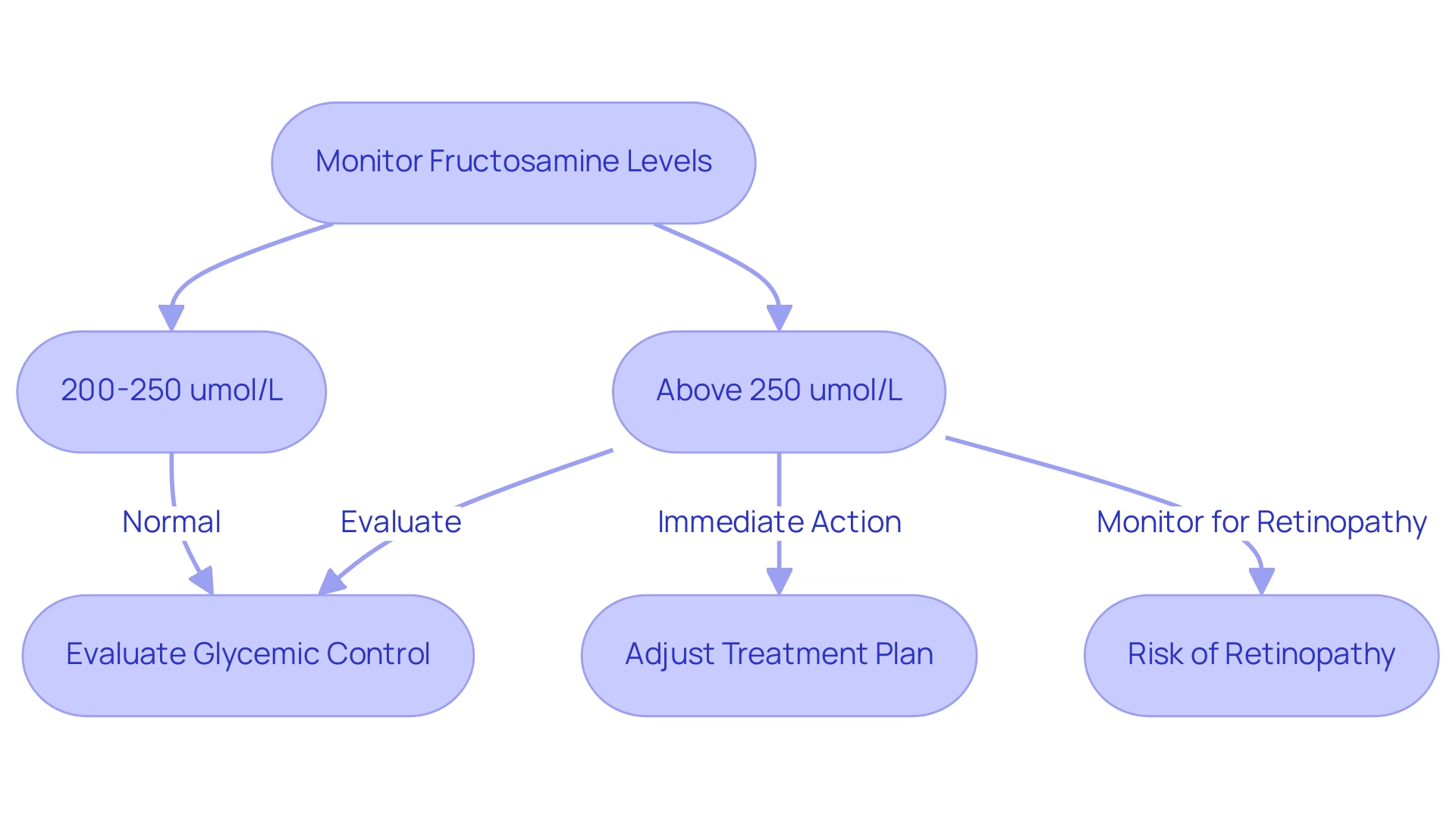
What is a Fructosamine Calculator and Why is it Important?
A calculator for assessing glycation is a vital tool for estimating average blood glucose concentrations based on the amount of a specific protein in the bloodstream. This measurement is particularly beneficial for individuals managing diabetes, as it allows for the transformation of test results into an estimated HbA1c value, which serves as a standard indicator of long-term glucose control. Typically, individuals enter their sugar measurement (measured in µmol/L), and the calculator provides an estimated HbA1c percentage.
Understanding this conversion is crucial for grasping short-term glucose control and can guide necessary treatment adjustments.
The importance of calculators for sugars is underscored by their relationship with fasting blood glucose measurements. Research indicates a fructosamine-albumin (FA) ratio correlation of 0.436 among Type 2 Diabetes Mellitus (T2DM) patients without chronic kidney disease (CKD), highlighting the significance of this statistic in evaluating glucose control and its practical implications for treatment. Furthermore, recent findings reveal that estimated blood glucose levels obtained from HbA1c measurements are more precise than those derived from other sources, especially when compared to actual fasting blood glucose levels across varying estimated glomerular filtration rate levels.
This distinction is crucial for healthcare providers as they determine the most effective monitoring strategies for their patients.
At T2DSolutions, we recognize the importance of tools like glucose level calculators in managing blood sugar levels. Our platform aims to provide comprehensive resources for individuals navigating their health care. Case studies illustrate the effectiveness of certain calculators in managing blood sugar levels, particularly among children and teenagers.
For instance, the case study titled "Usefulness of Fructosamine in Childhood Diabetes Management" demonstrates how these levels can indicate short-term glucose control, making them a practical and economical approach for assessing recent therapeutic effectiveness and guiding initial treatment choices in childhood care. The combined assessment of certain blood markers and HbA1c proves advantageous in unclear situations, enhancing the overall approach.
Healthcare providers utilize a fructosamine calculator to effectively monitor changes in blood sugar control. By offering timely feedback on glucose levels, these calculators empower individuals to take charge of their health management. Consistent use can lead to improved outcomes, as patients gain insights into their glucose fluctuations and can make informed decisions regarding their treatment plans.
As Dr. Natalya Akhetova, MD, from the Department of Endocrinology at Asfendiyarov Kazakh National Medical University, notes, "This article was published in the Journal of Diabetes Science and Technology," underscoring the credibility of the information shared. Overall, the significance of glucose monitoring tools in managing blood sugar levels cannot be overstated, as they serve as a crucial resource for both patients and healthcare providers in navigating the complexities of care. We encourage you to explore additional resources offered on T2DSolutions regarding blood sugar control.
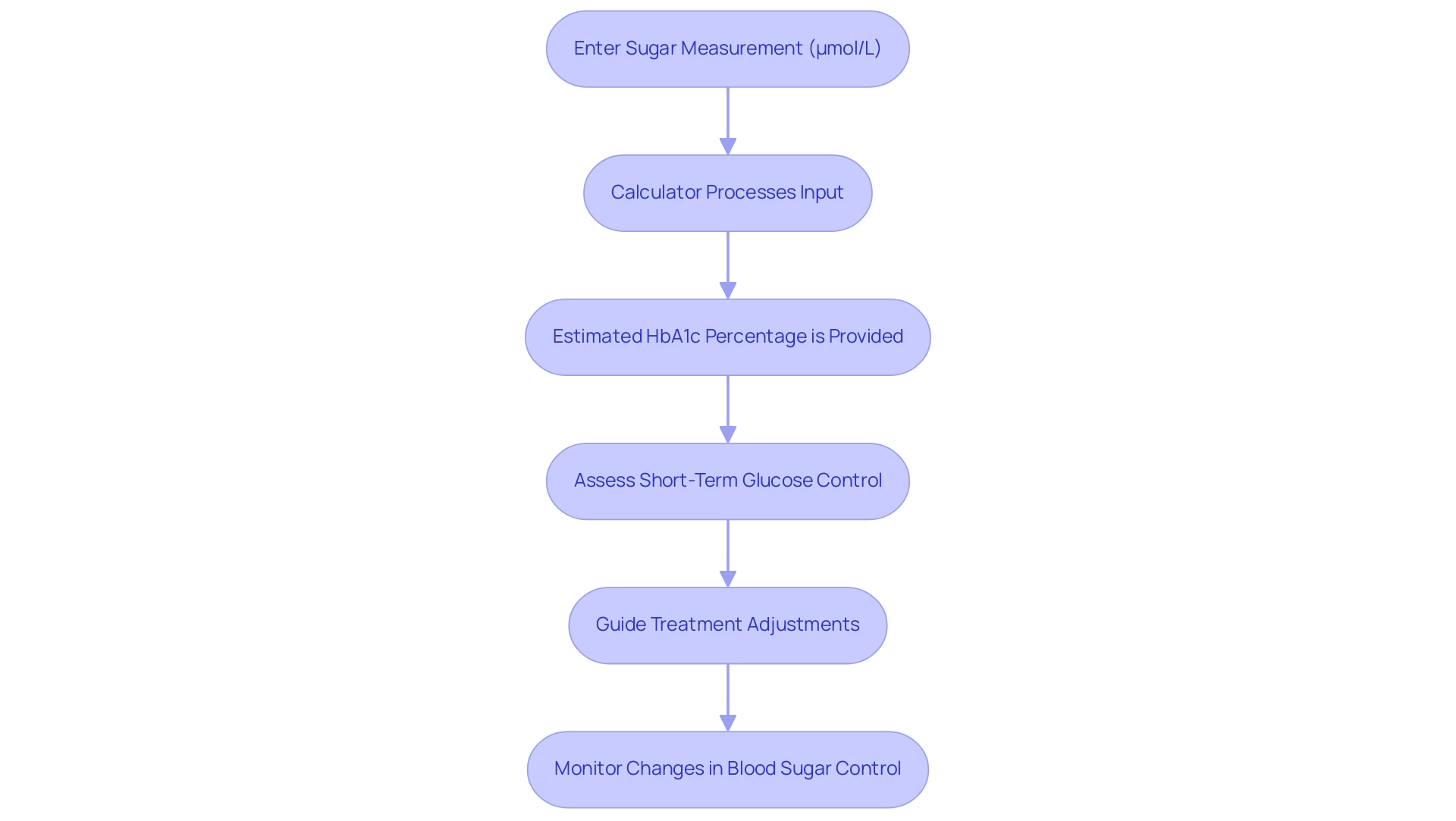
Step-by-Step Guide to Using the Fructosamine Calculator
To effectively utilize a blood sugar calculator for diabetes management, follow these compassionate steps:
-
Get Your Blood Sugar Measurement: Start by having your blood sugar assessed through a blood test at your healthcare provider's office. The result will be reported in micromoles per liter (µmol/L).
-
Access the fructosamine calculator by seeking reputable online calculators or mobile applications specifically designed for this purpose. Selecting a reliable source is crucial for accurate results.
-
Input Your Glycation Index: Enter the glycation index obtained from your test into the calculator. It's important to double-check the unit of measurement to prevent any errors in calculation.
-
Calculate Your Estimated HbA1c: After inputting your fructosamine amount, click the calculate button. The calculator will then provide you with an estimated HbA1c percentage, reflecting your average blood glucose levels over the past two to three months.
-
Interpret the Results: Compare your estimated HbA1c with the target range established by your healthcare provider. This comparison will help you assess your current glucose control status and understand how effectively your health plan is functioning. Remember, the association between high blood sugar and all-cause mortality was explained by hyperglycemia in 56% of Hispanic women, highlighting the critical need for effective glucose monitoring.
-
Discuss with Your Healthcare Provider: Share your results with your healthcare provider to discuss any necessary adjustments to your management plan based on the findings. Engaging in this dialogue is essential for optimizing your care. As Nader Rifai mentioned, the test plays an important part in evaluating metabolic control, making these discussions even more relevant.
In a case study involving a patient with a concentration of 586 µmol/L and an HbA1c of 11.5%, it was concluded that their condition was worsened by a recent infection, resulting in the initiation of insulin therapy. This emphasizes the significance of precise observation and analysis of certain measurements in effectively managing blood sugar. Additionally, fructosamine levels can serve as a substitute for average glucose levels, underscoring the importance of incorporating a fructosamine calculator into your oversight strategy.
By adhering to these steps, you can effectively use a fructosamine calculator as a valuable resource in your blood sugar control journey, ensuring that you remain informed and proactive in your care. You're not alone in this journey; the emphasis on community and teamwork is crucial in enhancing health results. Sharing your experiences with others can cultivate a supportive atmosphere for managing the condition. For additional resources and assistance related to blood sugar control, visit t2d solutions, your extensive resource center for Type 2 and Type 3 blood sugar education.
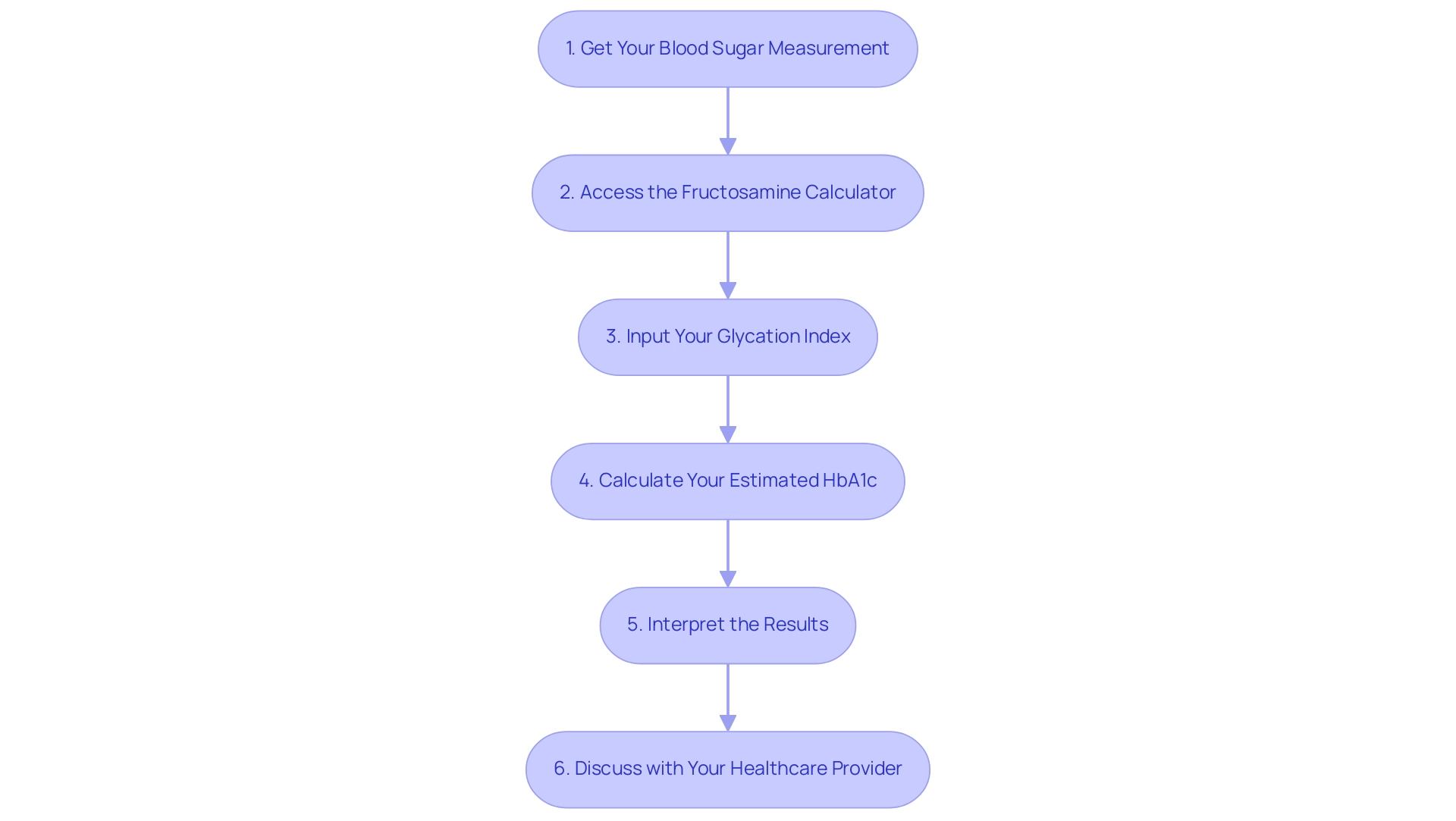
Interpreting Your Fructosamine Results: What Do They Mean?
Interpreting your glycation results is crucial for understanding your blood glucose control. The following ranges provide a helpful framework for assessing your values:
- Normal Range: A measurement below 285 µmol/L generally signifies good glycemic control. This indicates that your strategies for managing blood sugar are effective, and it’s wonderful to see your efforts paying off.
- Elevated Values: When amounts fall between 285 and 421 µmol/L, this suggests that blood glucose values have been higher than preferred. It’s understandable to feel concerned about this range, and it may be time to consider adjustments in your health control plan to enhance regulation.
- High Levels: Levels surpassing 421 µmol/L may indicate inadequate glycemic control. Such outcomes necessitate a prompt conversation with your healthcare provider. Together, you can reevaluate your treatment plan and explore necessary adjustments.
It’s important to acknowledge that sugar protein concentrations can be influenced by various factors, including dietary changes, exercise routines, and adherence to medication. For instance, research indicates that glycated albumin values can reach two to five times the upper limit of normal in cases of inadequately controlled blood sugar. This underscores the significance of regular monitoring. Additionally, expert analyses emphasize that understanding certain biochemical markers is essential for effective blood sugar management.
A study by de Oliveira Andrade et al. highlighted that each 1.0 μmol/L increase in this substance correlates with a rise in glucose levels of 0.5 mg/dL. This provides a clear relationship between these two metrics, which can be reassuring to understand. Furthermore, a study involving 125 alpacas showed that while a specific compound correlated positively with glucose levels, it did not relate to stress indicators. This suggests that stress can complicate interpretations of hyperglycemia, reminding us of the importance of a holistic approach to health.
As T2DSolutions launches as a new resource hub for education and community support regarding blood sugar issues, regular consultations with your healthcare provider are essential for maintaining optimal health. They can help you navigate the implications of your fructosamine results using a fructosamine calculator and adjust your care plan accordingly. To stay informed about valuable resources and insights, consider subscribing to T2D Solutions for the latest information in health condition management. Remember, you’re not alone in this journey—we are here to support you every step of the way.
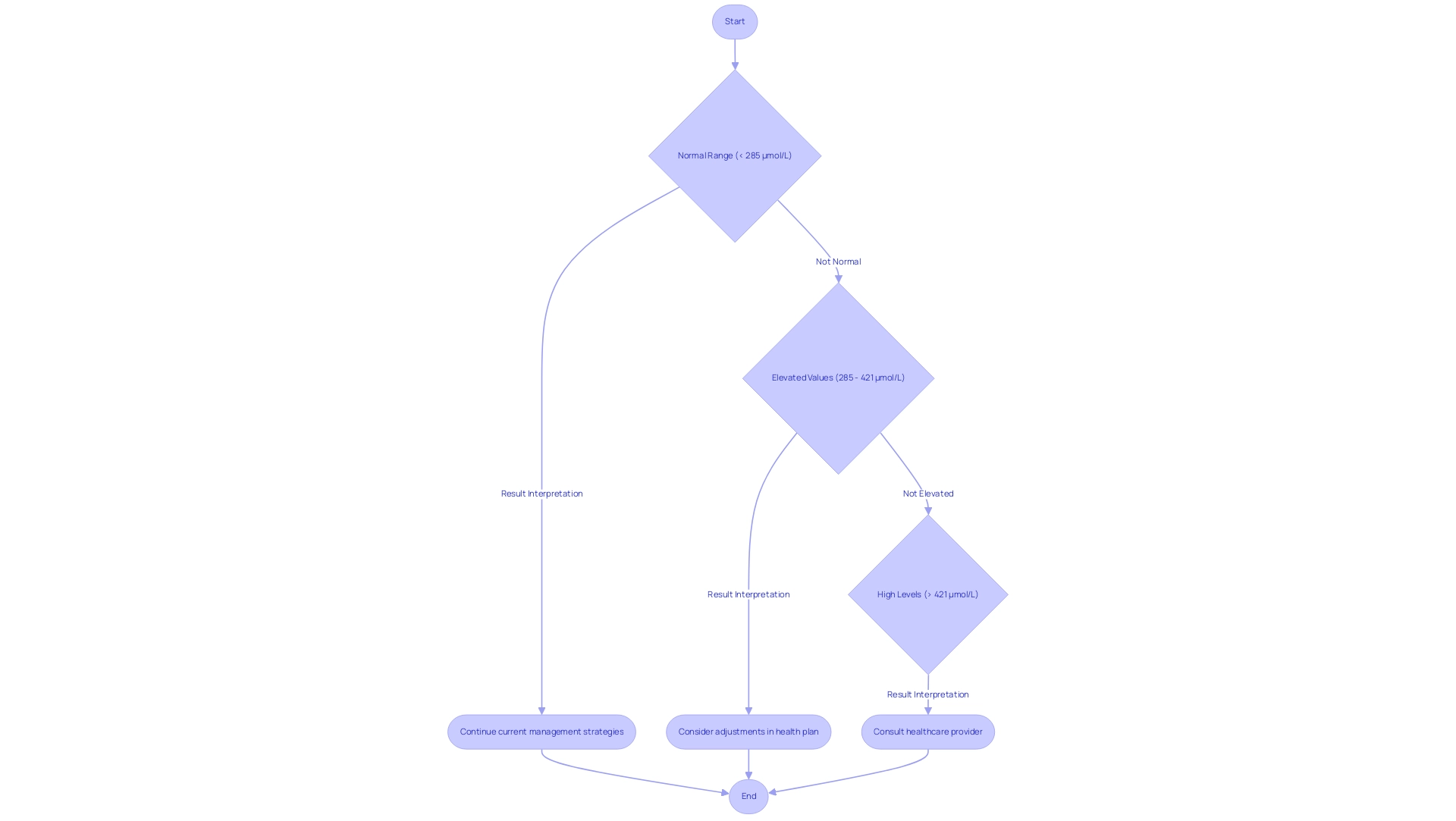
Limitations of Fructosamine Testing: What You Need to Know
Fructosamine testing, which can be assessed using a fructosamine calculator, serves as a valuable tool for monitoring short-term glucose control. However, it's essential to recognize its limitations.
- Influence of Protein Concentrations: Fructosamine levels can be sensitive to variations in serum protein concentrations, particularly albumin. Conditions like chronic kidney disease, which influence protein amounts, may lead to misleading fructosamine results, complicating diabetes management.
It's important to note that studies have shown Glycated Albumin (GA) is independently linked with blood glucose levels, suggesting it may offer a more dependable measure in specific populations.
- Short-Term Reflection: This test provides an average of glucose readings over the preceding 2 to 3 weeks. Therefore, it may not adequately represent long-term glycemic control, especially when compared to the more established HbA1c test, which reflects glucose levels over a longer duration.
The case study on Glycated Albumin and Fructosamine highlights that GA is a superior marker for monitoring glycemic control in patients with conditions that affect HbA1c reliability, such as chronic kidney disease.
- Not a Substitute for HbA1c: It's crucial to understand that fructosamine should not be relied upon as the sole indicator of glycemic control. Instead, it is most effective when used alongside other evaluations, like HbA1c, to develop a more comprehensive understanding of an individual's condition.
As pointed out by Antonio Nouvenne, MD, combining various testing techniques can enhance the precision of blood sugar control strategies.
- Variability in Results: Individual responses to glucose changes can vary significantly, leading to inconsistencies in results. This variability can present challenges in accurately interpreting the data for different patients or even for the same patient over time.
Moreover, results suggest that GA could be a better diagnostic assessment than fructosamine for identifying hyperglycemia, particularly in clinical care and epidemiological research.
Understanding these limitations is essential for effectively integrating the fructosamine calculator into your health strategy. By recognizing the factors that can influence test results, you can make more informed decisions about your health and treatment options. The emphasis on community and cooperation in managing the condition underscores the belief that controlling it is a shared journey. Together, with collective knowledge and support, we can work toward better health outcomes for everyone involved.
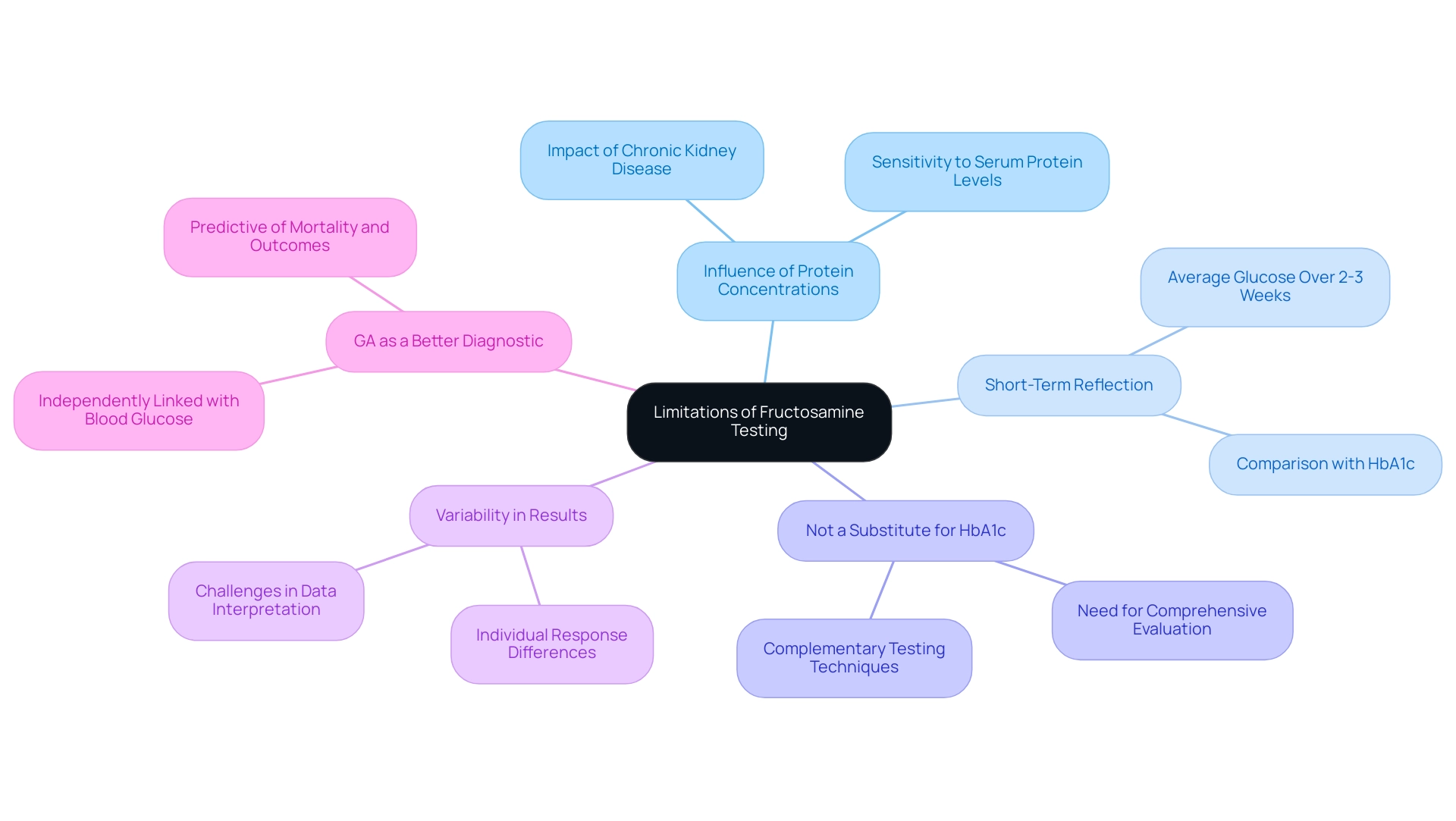
Additional Resources for Effective Diabetes Management
To effectively navigate your health management journey, consider utilizing these essential resources:
-
Diabetes Education Programs: It's important to seek out local or online education programs that provide comprehensive insights into managing your condition. T2DSolutions offers tailored educational programs designed to enhance your understanding of dietary recommendations, exercise plans, and self-monitoring techniques. Research shows that structured self-management education (DSME) interventions significantly enhance knowledge and self-efficacy, leading to improved clinical outcomes, including better blood glucose control. In fact, a systematic review and meta-analysis underscores the effectiveness of these interventions, highlighting their positive impact on glycemic control and cardiometabolic risk in adults with type 2 diabetes.
-
Support Groups: Engaging with a support group can be invaluable for those managing diabetes. T2DSolutions facilitates community support groups that offer emotional support and practical advice from individuals who share similar experiences. Community support has been shown to cultivate resilience and enhance health outcomes, making it a vital element of effective management.
-
Mobile Apps: Consider utilizing applications designed for health monitoring to assist you in tracking blood glucose levels, medication schedules, and food consumption. T2DSolutions provides suggestions for the best apps available, simplifying the organization process and enabling you to stay informed about your health.
-
Healthcare Provider Consultation: Regular meetings with your healthcare provider are essential for tailored advice and adjustments to your care plan. These check-ins ensure that your treatment remains aligned with your evolving health needs.
-
Online Resources: Platforms like T2DSolutions offer a wealth of information on health control, including expert articles, research updates, and community support. Utilizing these resources can deepen your understanding and empower you to make informed decisions about your health. Notably, investing in diabetes education can help mitigate costs associated with complications, such as the annual screening for chronic kidney disease, which can amount to $21,000.
By actively engaging with these resources, including those offered by T2DSolutions, you can enhance your knowledge of diabetes management and significantly improve your overall health outcomes. Remember, you're not alone in this journey, and we are here to support you every step of the way.
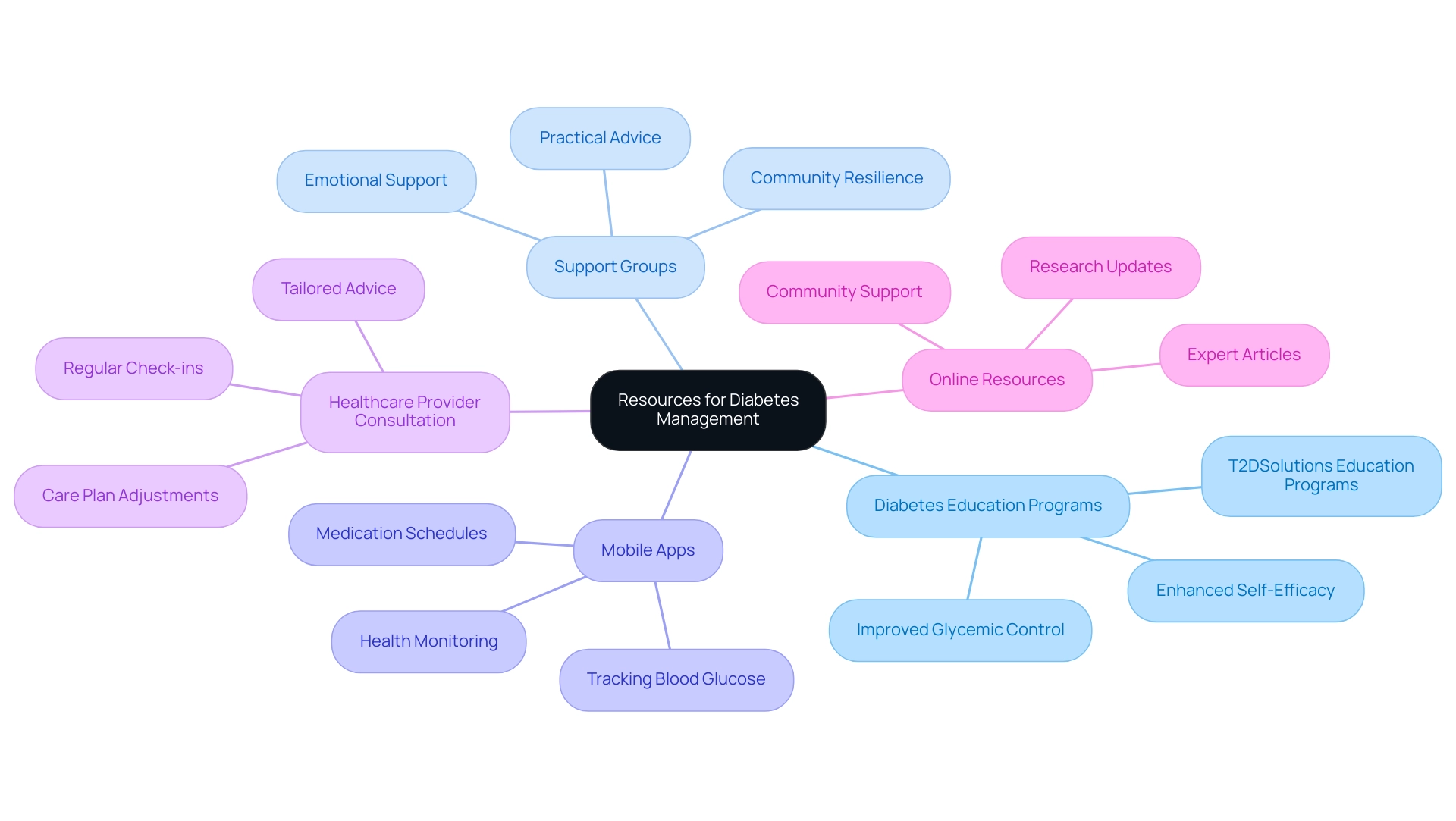
Conclusion
Incorporating fructosamine testing into diabetes management is a pivotal step toward achieving better health outcomes. This tool offers a unique perspective on short-term glycemic control, allowing you to gain insights into your blood glucose levels over the past few weeks. Unlike the traditional HbA1c test, fructosamine provides timely information that can be crucial for making necessary adjustments in treatment plans, especially after recent changes in lifestyle or medication.
Understanding how to interpret fructosamine results is equally important. By recognizing the ranges of fructosamine levels, you can assess your glycemic control and work with your healthcare provider to fine-tune your management strategies. This collaborative approach not only enhances individual care but also fosters a supportive community that empowers you to take charge of your health.
Despite its advantages, it is essential to acknowledge the limitations of fructosamine testing. It should not serve as a standalone measure but rather as part of a comprehensive diabetes management strategy that includes other assessments like HbA1c. By integrating these various tools, you can gain a clearer, more complete picture of your diabetes management journey.
Ultimately, the integration of fructosamine testing and calculators into routine diabetes care can significantly enhance your ability to monitor and adjust treatment strategies effectively. With the right resources and support, you can navigate your diabetes management with confidence, leading to improved health outcomes and a higher quality of life. Engaging with educational programs, community support, and regular consultations with healthcare providers can further bolster this journey, making it a collaborative effort toward better health.
Frequently Asked Questions
What is fructosamine and why is it important?
Fructosamine is a compound that forms when glucose binds to proteins in the blood, primarily albumin. It is an important indicator of average blood glucose values over the preceding 2 to 3 weeks, making it useful for evaluating short-term glycemic control.
How does fructosamine differ from HbA1c?
Fructosamine provides an indication of glucose concentrations over a shorter period (2 to 3 weeks) compared to HbA1c, which reflects glucose levels over approximately three months. This makes fructosamine particularly useful for individuals who have recently changed their treatment or lifestyle.
What are typical fructosamine levels for individuals with Type 2 Diabetes?
The average levels of glycated proteins in individuals with Type 2 Diabetes typically range from 200 to 285 umol/L. Levels exceeding 250 umol/L are significantly associated with the onset of retinopathy, even when HbA1c levels are below 7.0%.
Why is fructosamine considered essential in diabetes management?
Fructosamine is essential in diabetes management as it provides a valuable tool for assessing glycemic control, especially in cases where HbA1c may not give a complete picture, such as in hemoglobinopathies or conditions affecting red blood cell turnover.
How can fructosamine testing assist patients?
Fructosamine testing can help patients experiencing fluctuating blood glucose readings by guiding timely dietary or medication adjustments based on recent glucose levels.
What is the relationship between fructosamine levels and health outcomes?
Recent studies have shown J-shaped connections between amino sugar concentrations, including fructosamine, and various health outcomes, including mortality. Elevated amino sugar concentrations are linked to increased risks, emphasizing the need for careful monitoring.
What tools are available for managing blood sugar levels?
T2DSolutions offers calculators for converting specific sugar levels to estimated HbA1c values, aiding individuals in understanding their glycemic control and informing treatment decisions.
How does the fructosamine calculator work?
The fructosamine calculator allows individuals to input their sugar measurement (in µmol/L) to receive an estimated HbA1c percentage, which helps in understanding short-term glucose control and guiding treatment adjustments.
What role do glucose level calculators play in diabetes management?
Glucose level calculators are important tools for managing blood sugar levels, providing timely feedback on glucose fluctuations, and empowering individuals to make informed decisions regarding their treatment plans.
What is Type 3 Diabetes and its significance?
Type 3 Diabetes is associated with Alzheimer’s disease and insulin resistance in the brain. Raising awareness about this condition contributes to better preventive strategies and care for individuals at risk.
